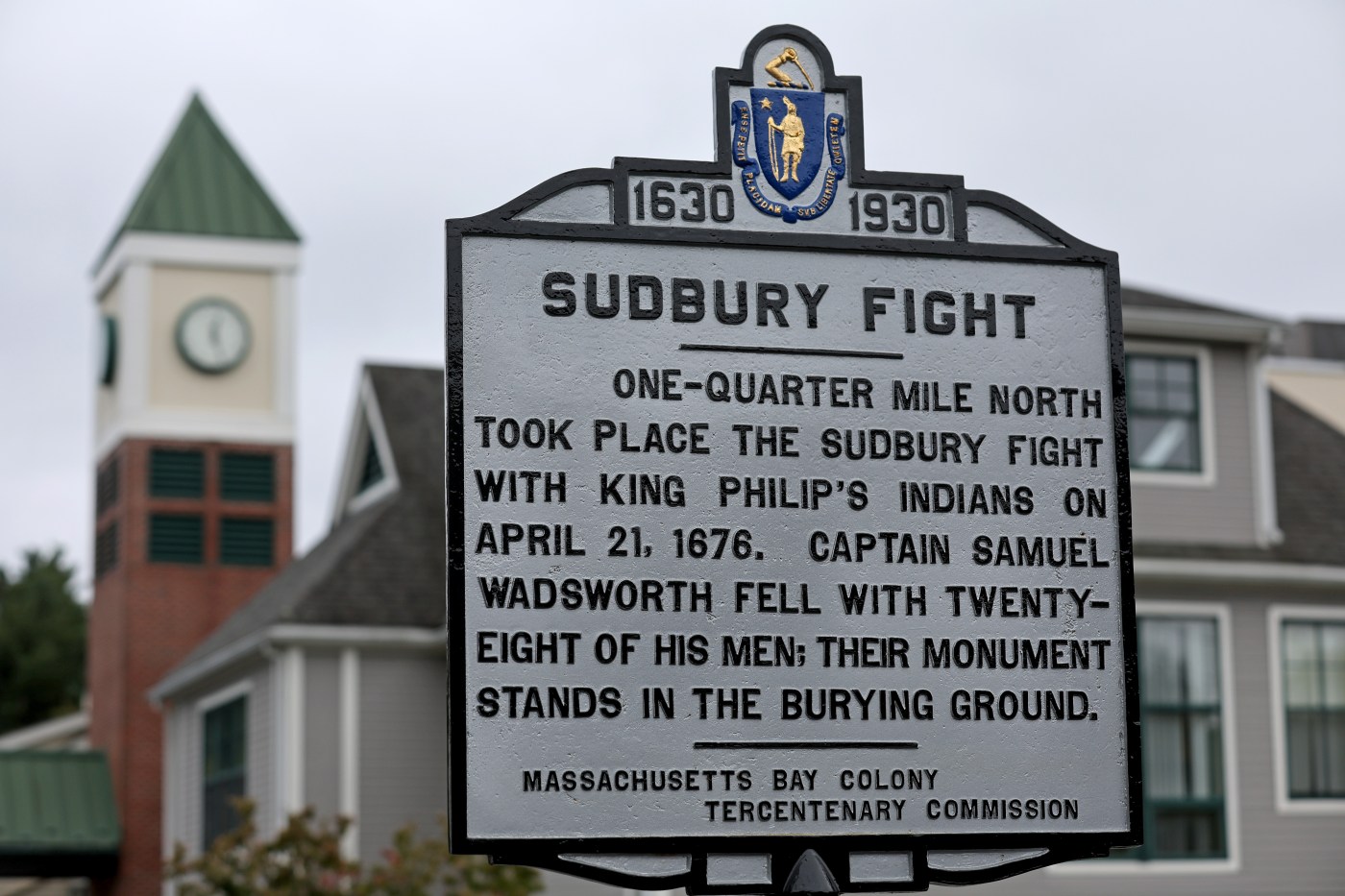
Sudbury may be next Massachusetts town to take down ‘one-sided’ historical signs
Sudbury is exploring whether it should become the next Massachusetts town to remove signs commemorating the founding of the Massachusetts Bay Colony and if there’s a better way to present the complicated history.
What to do with the tercentenary markers has long been a topic of discussion in Sudbury. The conversation has ratcheted up over the past few months after three signs came down in neighboring Concord in late January.
In 1930, the Massachusetts Bay Colony Tercentenary Commission distributed 275 cast-iron markers to 95 cities and towns across the Commonwealth to recognize the 300th anniversary of the original colony’s founding.
As time has gone on, many signs have been lost or fallen into a state of disrepair. The markers have also become a talking point as communities grapple with whether they convey an accurate history or fall short.
Michael Wallace, tasked with leading discussion on the issue for the Historical Commission, moved to affluent Sudbury, a Greater Boston suburb of roughly 19,000 people, in July 2023 and joined the Commission last November. The conversation around the historical markers predates his time in town, he said.
Sudbury, incorporated in 1639 with a population of 476, is one of the oldest towns in New England, according to its town website.
Wallace told the Herald that it’s “Impossible to say” how far away the town is from seeing its five markers come down if it takes that route.
“The goal is to build consensus,” Wallace told the Herald in a phone interview on Friday. “This is about our town’s history and its public history. It’s the history that we tell about ourselves.”
“It’s good to reach a position where everyone feels good about that,” he added. “100% of the people can’t feel 100% happy, but to arrive at some place where there is a consensus that what we are doing is reflective of our town and our history.”
The Sudbury Clergy Association, in a letter in January 2022 to the town’s Diversity, Equity and Inclusion Commission, said it was “concerned about the representation of First Peoples (Indigenous People) in public markers.”
Three of the signs, clergy members wrote, “suggest, without providing any context, that during the so-called King Philip’s War, colonial settlers were defending their land from attacks by First Peoples.”
The conflict, known as the Sudbury Fight, was fought in town in 1676 and could be looked at differently than in 1930, clergy members added.
“Since First Peoples resided on this land for thousands of years before colonial settlers arrived, in the broader context,” the letter states, “they can be understood to have been defending their ancestral land from invasion by colonial settlers.”
Wallace said a tercentenary marker that commemorates the establishment of the original Sudbury plantation is “controversial in the sense that it’s only speaking about the Puritans … It doesn’t reference the fact that there’s a Native American population that was here long before any white settlers.”
The state Department of Transportation notified the Historical Commission in the spring of 2023 that it planned to “remove, restore and reset the Sudbury Fight” marker on Route 20. Members responded with a letter requesting the sign not be put back up.
The controversial marker was reinstated because MassDOT only has a say in repairing and maintaining the signs and not removing them permanently.
A local nonprofit, Athina Education, held a forum in April 2023 on the markers, which included Nipmuc citizen Andre Strongbearheart Gaines Jr. as a panelist. He said the signs are one-sided, highlighting how none of them convey that after King Philip was killed, his skull was placed on a rod for over 20 years.
“We’re talking about taking signs down, this is what I’m thinking about,” Gaines said. “How do you think our people felt walking by that skull every day? It’s the same thing with these signs.”
“They’re grim reminders of the assimilation, the colonization … the brutality that was set forth in law,” he added. “Why is it so hard to understand that these signs are signs of brutality?”
Critics have also taken exception to the signs carrying a depiction of the Massachusetts state seal originally adopted in 1898. It features a disembodied arm of Plymouth colony military adviser Myles Standish holding a sword over the head of a Native American figure in a peaceful stance.
A state commission tasked with rethinking the seal and motto disbanded without any specific recommendations after two years of work.
Concord officials removed their three tercentenary markers in late January after their Historical and DEI Commissions argued the signs had harmed Indigenous people and didn’t accurately reflect what happened when settlers founded the town in 1635.
State highway crews restored 21 historic markers found in 10 cities and towns, all in central or western Massachusetts, in 2019. At the time, the agency recovered roughly 174 of the original 275 signs.
One sign in the Cape Ann town of Gloucester, on the North Shore, was unveiled in July after it received a fresh restoration. It had “rusted and disintegrated almost beyond repair,” officials said in an advertisement for the event.
Gloucester’s three other signs are also being restored at an individual cost of $3,250 in state Community Preservation Act funds. A document outlining the project indicates a local historian provided “more accurate language” for the markers.
“Scattered across the state, these markers punctuate the land with an array of familiar myths,” the document states. “Seen in this light, the restoration of the Tercentenary Commission markers to their original condition is an opportunity for a reexamination of how we interpret and communicate public memory and how we can make our heritage more inclusive.”
In Sudbury, the Historical Commission is set to meet with the Historic Districts Commission in late October to discuss recommendations that will be made to the Select Board, which has the final say on the markers’ fate, Wallace said.
“Whether you think they are discriminatory or not, they were erected in the 1930s in a particular context of slower automobiles and slower roads,” he said. “Around the state a lot of these signs are missing, many are in bad condition. … These aren’t things really engaging to the public anymore, so it’s exciting to think about what we can do that’s better.”
A sign for the Portion of the Goodenow Garrison House in which the settlers took refuge from King Philip’s Indians during the battle of April 18-21, 1676. (Photo By Matt Stone/Boston Herald)
A sign for the Haynes Garrison House the home of Deacon John Haynes. Here the settlers by their brave defense saved the town when King Philip and his Indian warriors attacked Sudbury in April, 1676. (Photo By Matt Stone/Boston Herald)


